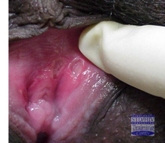Herpes Simplex Virus (HSV) - Genital Herpes
o There are two main types of HSV. HSV I usually presents on the mouth (i.e. cold sores) and is very common (80% of U.S. population has HSV I). HSV II is usually genital and is also common (1 in 5 adults), but both types I and II can be passed to the mouth or genitals through direct contact with a herpes sore or infected tissue.
| Herpes Sores on Penis |
Herpes Sores on Inner Labia |
 |
 |
| Source: CDC |
Source: Cincinnati STD/HIV
Prevention Training Center |
o Blisters and sores may form and reoccur at the site of infection with HSV. Some people may feel a tingling or numbness before an outbreak occurs.
o Having HSV can increase the likelihood of HIV transmission during sex.
o Up to 90% of infected individuals do not report any symptoms - which means most people don't know they have HSV. HSV infections are often passed when there are no sores present through asymptomatic viral shedding.
o Most herpes tests are done by taking a sample from a blister or sore. There are also some herpes blood tests available. (Ask a clinician for more details.)
o HSV is a lifelong infection and there is no cure. However, there is treatment for HSV symptoms, including daily viral suppression therapy, if appropriate.
o Condoms are a good barrier to HSV transmission when they cover the infected area.
| Asymptomatic viral shedding is when live virus is produced and released through infected skin even though there is not a visible sore or lesion. |